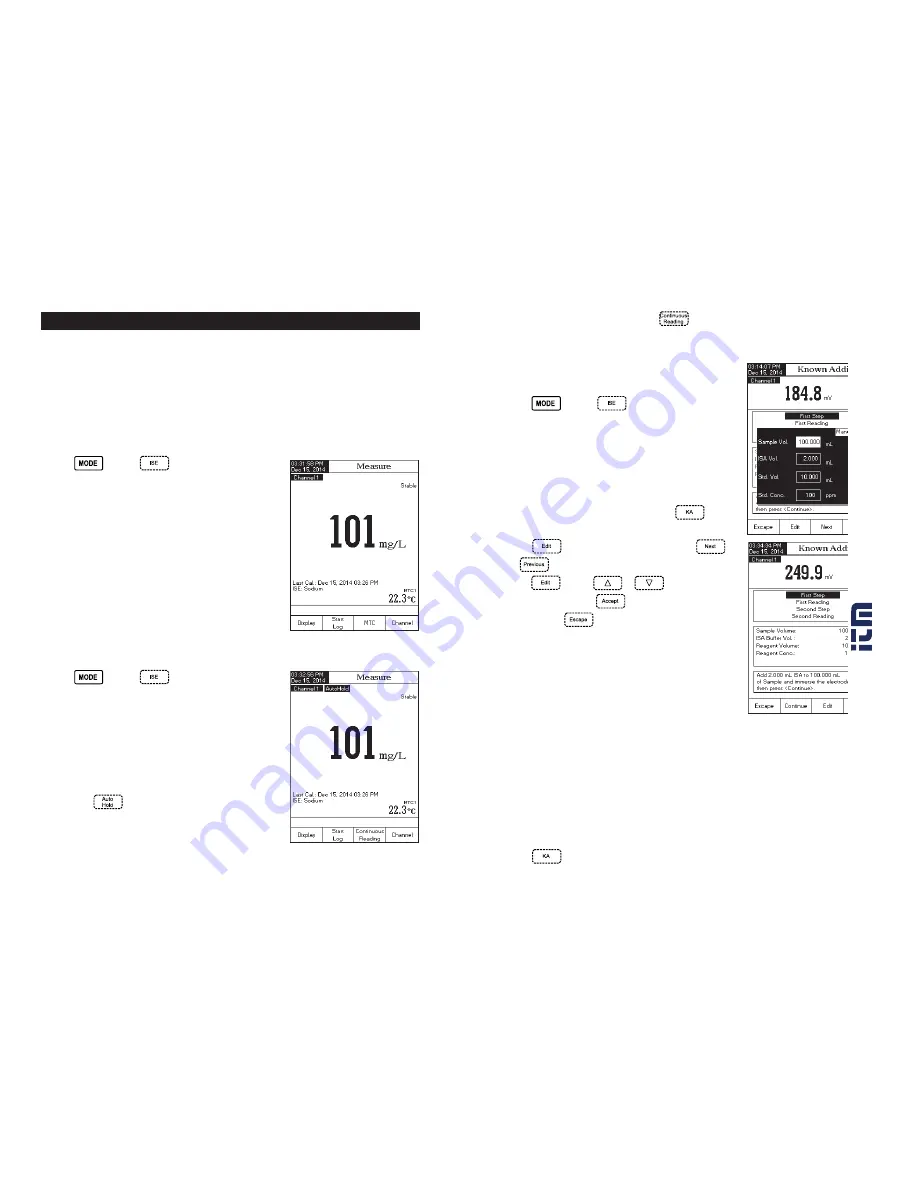
56
57
ISE MEASUREMENT (HI 5522 only)
• To return to normal Measure mode press
.
Note
: If the reading is out of range, “
----
” may be displayed on the LCD.
KNOWN ADDITION
To measure the concentration of a sample using the Known
Addition incremental method:
• Press
and then
to select ISE Measure mode
for the selected channel.
• Select the Known Addition method (see ISE Setup for details).
• Prior to starting a KA procedure, the ISE sensor must be
calibrated with a minimum of two standards containing ISA.
The slope of the electrode will be used in all calculations
involved in KA.
• If following an established procedure: Press
, Edit
the method variables and follow the procedure below.
• Press
to set the method parameters. Press
/
to select next/previous parameter to edit, then
press
and use
or
to set the desired
parameter value. Press
to save the modified value
and then press
to exit method parameters edit menu.
• If developing a procedure: Before attempting Known addition
analysis it is important to determine what sample volume,
standard concentration and standard volume will produce the
best results. As a general rule, the addition of standard
should change the mV value of the sample by 15 - 20 mV.
For a positively charged Ion (i.e. Sodium, Potassium, Calcium),
the standard addition should increase the mV. For a negatively charged Ion (i.e. Sulfide, Fluoride,
Chloride), the standard addition should decrease the mV. Start with a small trial. For example: Measure
50 mL of sample, add a magnetic stir bar, place on a stirrer, add ISA (consult ISE manual) and place ISE
electrode tip into the sample. Put instrument in mV mode and record the observed mV. Using a
micropipet, add a volume of the highest ISE standard available (i.e. 0.1M or 1000 ppm). Start by adding
500 µL at a time (for example) Watch the change in mV. When you have observed approximately a 15
mV change from the original sample. Calculate the total volume added. Adjust sample and standard
volumes proportionally to standard volumes that can be measured with accuracy. Use volumetric pipettes
for standard, ISA and sample addition.
• Press
: Edit the procedure variables to the volumes determined in the prior step.
Make sure the instrument and ISE sensor have been calibrated before making ISE measurements.
When using one of the incremental methods for measurement, at least a two-point ISE calibration must be
performed to establish the electrode slope.
For accurate measurements, add the appropriate
ISA
(Ionic Strength Adjuster) to both samples and standards.
Consult ISE manual for sensor preparation details.
DIRECT MEASUREMENT
To measure the concentration of a sample using the Direct reading mode:
• Press
and then
to select
ISE Measure
mode
for the selected channel.
• Select the Direct reading mode (see ISE Setup for details).
• Add ISA to the sample solution.
• Submerge the Ion Selective Electrode tip and the temperature
probe approximately 2 cm (1”) into the sample. Allow time
for the electrode to stabilize.
• The measured concentration value will be displayed on the
LCD in the selected units.
Note
: If the reading is out of range, “
----
” may be displayed
on the LCD.
DIRECT/AUTOHOLD MEASUREMENT
To measure the concentration of a sample using the Direct/AutoHold reading mode:
• Press
and then
to select
ISE Measure
mode
for the selected channel.
• Select the Direct/AutoHold reading mode (see ISE Setup for
details).
• Add ISA to the sample solution.
• Dip the Ion Selective Electrode tip and the temperature probe
approximately 2 cm (1”) into the sample to be tested.
• The measured concentration value will be displayed on the
LCD. Press
, the “
AutoHold
” indicator will blink on
the LCD until the stability criterion is reached. The concentration
value will be frozen on the LCD, along with “
AutoHold
”
indicator.
w
w
w
.
.c
om
in
fo
rm
at
io
n@
itm
.c
om
1.
80
0.
56
1.
81
87
















































